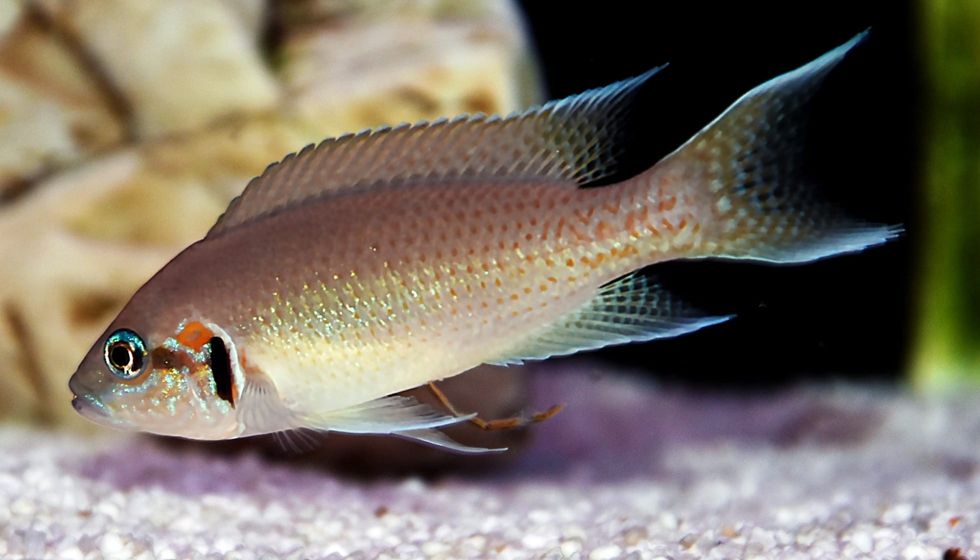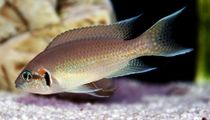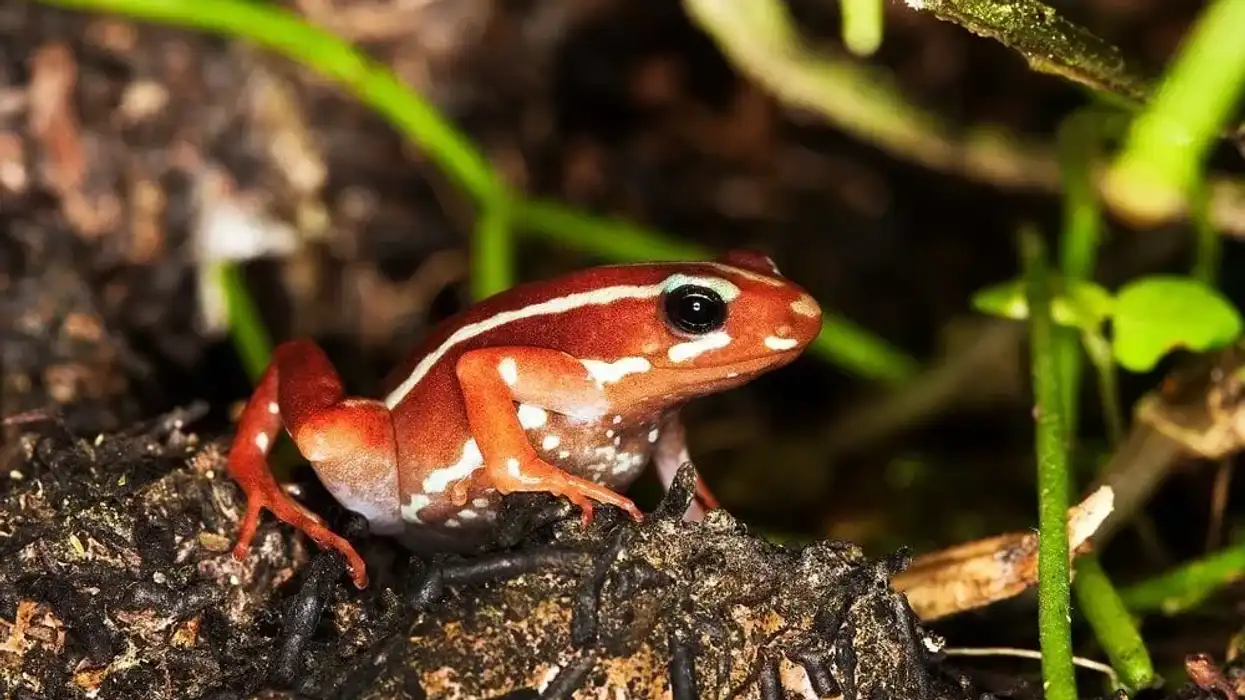Fun Fairy Cichlid Facts For Kids

Content
- What type of animal is a Fairy Cichlid?
- What class of animal does a Fairy Cichlid belong to?
- How many Fairy Cichlids are there in the world?
- Where does a Fairy Cichlid live?
- What is a Fairy Cichlid's habitat?
- Who do Fairy Cichlids live with?
- How long does a Fairy Cichlid live?
- How do they reproduce?
- What is their conservation status?
- What do Fairy Cichlids look like?
- How cute are they?
- How do they communicate?
- How big is a Fairy Cichlid?
- How fast can a Fairy Cichlid swim?
- How much does a Fairy Cichlid weigh?
- What are the male and female names of the species?
- What would you call a baby Fairy Cichlid?
- What do they eat?
- Are they aggressive?
- Would they make a good pet?
- Did you know...
- The Fairy Cichlid's compatibility
- Naming the Fairy Cichlid
Does learning about various species of fish excite you? Then you should read this article on Fairy Cichlids.
The Fairy Cichlid (Neolamprologus brichardi) is a fish that is native to Lake Tanganyika in East Africa. The Fairy Cichlid is a member of the order Cichliformes and the phylum Chordata.
It is a freshwater fish that dwells on rocks and is most commonly found at a depth of 15-75 ft (4.6-22.9 m). Even after sharing its natural habitat with various other species of fish, the Fairy Cichlid manages to stand out.
It is an extremely graceful fish and is a pleasure to look at. It is a very common fish in the trade market and is found in the aquarium of numerous houses globally.
It makes an excellent pet as this fish does not require high maintenance and is pretty easy to breed. All it needs is a specifically sized tank, compatible tank mates, a suitable tank temperature, and sufficient food to survive inside a tank.
Keep on reading to know more about this fish. To learn more about other fishes found in the wild as well as in the tank, check out the convict cichlid and ram cichlid.
Fairy Cichlid Interesting Facts
What type of animal is a Fairy Cichlid?
The Fairy Cichlid (Neolamprologus brichardi) is a freshwater fish native to Africa's Lake Tanganyika.
What class of animal does a Fairy Cichlid belong to?
The Fairy Cichlid (Neolamprologus brichardi) belongs to the Actinopterygii class of the Animalia kingdom. This fish is a member of the family Cichlidae and the order Cichliformes. The Fairy Cichlid belongs to the genus of Neolamprologus.
How many Fairy Cichlids are there in the world?
The Fairy Cichlid (Neolamprologus brichardi) is a famous aquarium fish found in aquariums all over the world. They are also found in huge numbers in the wild.
The Fairy Cichlid is bred both in the wild and in captivity. It is pretty difficult to calculate the exact population of such fish species. However, certainly, their population is not at risk at the moment.
Where does a Fairy Cichlid live?
The Fairy Cichlid is found in Lake Tanganyika in East Africa where they live with more than 250 other species of Cichlid and about 100 species of other freshwater fishes.
The Fairy Cichlid is also a popular aquarium fish and is found globally in aquariums.
What is a Fairy Cichlid's habitat?
The natural habitat of the Fairy Cichlid is in the freshwater of Lake Tanganyika. This fish is generally found living in the lake at a depth of 15-75 ft (4.6-22.9 m).
The depth gives the Fairy Cichlid the advantage of getting food in sufficient amounts. The temperature in Lake Tanganyika at this depth is said to be somewhere between 77-79 F (25-26 C) with a pH level of 8.4-9.2.
The rocky habitat of the lake helps the fish to rest on the rocks and hide behind them when threatened.
The adults even lay their eggs on the rocks. They share their natural habitat with various other species and the Fairy Cichlid has done a commendable job in standing out among everyone.
The Fairy Cichlid is a common fish for those with a fishkeeping hobby. Keeping a fish of this species in a home aquarium is practiced globally.
A tank of 40 gal (151 l) is enough to accommodate these medium-sized fishes. However, the tank size should be about 75 gal (284 l) when they are kept in an aquarium with other species of fish. While having this fish in the aquarium, it is important to make it feel at home.
A water temperature of 77-79 F (25-26 C) and a pH level of 8.4-9.2 should be maintained to match their natural habitat. The aquarium should be filled with various rocks and plants.
Who do Fairy Cichlids live with?
In its natural habitat, the Fairy Cichlid (Neolamprologus brichardi) is found living in huge schools. Spotting a school of about 1000 Fairy Cichlids together is not uncommon.
The Fairy Cichlid is one of the fishes that look after the eggs and fry of other fishes of the same species along with their own. They even swim around and look for food together.
However, inside an aquarium, this Fairy Cichlid is a very unpredictable species of fish. It is observed that different fishes of this species show different behavior in an aquarium.
One small school of Fairy Cichlids can live in harmony with each other and fishes of other species. Whereas, another school might behave differently.
The dominant pair formed inside an aquarium can chase off or harm other fishes living in the aquarium. However, they have great parental instincts even inside the aquarium and care a great deal for the young ones.
How long does a Fairy Cichlid live?
A Fairy Cichlid (Neolamprologus brichardi) can live a healthy life of about eight years on average. Under the right circumstances and with proper care it can live up to 10 years.
How do they reproduce?
Breeding Fairy Cichlids in captivity is pretty easy. Given the ideal conditions, Fairy Cichlid can spawn within six weeks of being introduced to the dedicated tank.
Before breeding occurs, a compatible male and female start doing activities in pairs instead of their usual school. The breeding pairs show certain changes in behavior before spawning.
They spend most of their time near the rocks and look for a secure space to lay their eggs on. Young adults can lay up to 50-60 eggs at once while older ones are capable of laying more eggs. An older female can lay up to 100-120 eggs.
This species can spawn every 14-40 days but can choose to go on a 'reproductive rest' for a couple of months. In the wild, spawning occurs similarly.
This species of fish is known to have great parental instincts and both the adults take an active part in looking after the eggs. The females are responsible for taking care of the egg, whereas the males take care of the territory.
The elliptical-shaped brown-green eggs are laid on the rocks and it takes an egg about 72 hours to hatch. At birth, they are fairly underdeveloped and are just about an inch long. The young ones stay close to their parents even after one week of hatching.
However, they can be seen together with adults and sub-adults. The parents take care of the young ones of other fishes of the species along with their own.
What is their conservation status?
The International Union for Conservation of Nature the IUCN has given Fairy Cichlid (Neolamprologus brichardi) the status of Least Concern in their Red List. The Fairy Cichlid is bred in the wild as well as inside the aquarium and is found in the aquarium of numerous houses all over the world.
No conservation efforts are being made for this species as of now. So, it can be concluded that there is no immediate harm to the population of this fish.
Fairy Cichlid Fun Facts
What do Fairy Cichlids look like?
The Fairy Cichlid (Neolamprologus brichardi) has an elongated yet laterally compressed body with a continuous dorsal fin. They also have a lyre-shaped tail fin. The most common color of this fish is olive or grayish brown.
It has metallic blue colors near the edge of the tails and around the eyes. In addition to that, this fish has various black, yellow, and blue facial lines. However, these facial lines can be absent in certain variants of the fish.

We've been unable to source an image of a Fairy Cichlid and have used an image of a Brichardi cichlid instead. If you can provide us with a royalty-free image of a Fairy Cichlid, we would be happy to credit you. Please contact us at hello@kidadl.com.
How cute are they?
The Fairy Cichlid is an extremely attractive species of fish. The gorgeous color and facial lines add to its cuteness. The beauty of the Fairy Cichlids is one of the reasons for them being popular pets.
How do they communicate?
Like most fishes, the Fairy Cichlid communicates through gestures and movements. It sends out vibrations to warn others of potential danger.
How big is a Fairy Cichlid?
Most Fairy Cichlids are 3 in (7.6 cm) long. Some fishes of this species grow up to 4 in (10.2 cm). Males are noticed to be comparatively bigger than females. Fairy Cichlids bred in the aquarium tend to grow bigger than the ones in the wild. Compared to a Rainbow Cichlid, it is much shorter in size.
How fast can a Fairy Cichlid swim?
The Fairy Cichlid (Neolamprologus brichardi) is an active fish that is found swimming most of the time in search of food. However, their exact speed is not known.
How much does a Fairy Cichlid weigh?
The Fairy Cichlid is a medium-sized species of fish with the male being slightly heavier than the female. The exact weight of this species is unknown.
What are the male and female names of the species?
The male and female fishes of this species do not have any specific names. They are simply referred to as male Fairy Cichlids and female Fairy Cichlids.
What would you call a baby Fairy Cichlid?
Young ones of all species of fish are referred to as fry. So, the baby of Fairy Cichlid is referred to as the same.
What do they eat?
Fairy Cichlids living in Lake Tanganyika are carnivorous species that prey on crustaceans. Daphnia, copepods, Mysis shrimp, and Brine shrimp are a major part of their diet. Fairy Cichlids are also seen to feed on plankton found in that area of the water column. They swim around in schools looking for food.
Fairy Cichlids living in an aquarium have a slightly different diet. The larvae should be given food two to three times per day.
They should be fed with living species that can be easily devoured like baby brine shrimp. The fish should be supplied with a sufficient amount of small live species like worms and mosquito larvae to match the foods from their natural habitat. In addition to this, these fishes should be fed with prepared foods consisting of vegetables.
Are they aggressive?
The Fairy Cichlid (Neolamprologus brichardi) is a semi-aggressive species of fish. They have rather unpredictable behavior while living in the tank.
When introduced to the tank with other species and plants, some of the fishes do not seem to mind living in harmony but others can form a dominant pair and chase away the other fishes. They are even capable of attacking the fish that can hurt them.
In the wild, a male Fairy Cichlid responsible for protecting their territory can show aggressive behavior.
Would they make a good pet?
The Fairy Cichlids are very popular fishes in the fishkeeping hobby and are found in aquariums all over the world. They are attractive fishes that are not very difficult to maintain.
So, they are the perfect fishes to be kept in aquariums as pets. However, these fishes need specific water conditions and tank size to survive in captivity.
A temperature of 77-79 F (25-26 C) and a pH level of 8.4-9.2 is the most suitable for this fish. Fish tanks with sufficient space and decent water movement will work just fine for this species.
A couple of plants and rocks should be introduced into the tank. These plants and rocks will help the Fairy Cichlids feel at home.
Another reason for this fish being a perfect pet is that Fairy Cichlid breeding is pretty easy. Feeding them sufficiently and regular water changes will keep these fish healthy inside a tank.
Did you know...
Various studies suggest that the facial stripe patterns of these fishes have evolved over the years.
The Fairy Cichlid's compatibility
Fairy Cichlid tank mates include the Ornate Julie and other medium-sized fishes. The preferred tank size for these fishes is 40 gal (151 l) but they require a much bigger tank while sharing space with other fishes.
In such a case, the preferred size of the tank is about 75 gal (284 l). People who keep these fishes as a hobby or study them introduce various plants and rocks to the tank.
Naming the Fairy Cichlid
The Neolamprologus brichardi (Fairy Cichlid) goes by many names. For a long period, they were referred to as the 'Princess of Burundi' in trade markets. Brichardi comes from the 'Pierre Brichard', who was a Belgian responsible for setting up a collection station to export cichlids. Another common name for this fish is Lyretail Cichlid.
Here at Kidadl, we have carefully created lots of interesting family-friendly animal facts for everyone to discover! Learn more about some other fish from our Peacock Cichlid Fun Facts and Firemouth Cichlid Interesting Facts pages.
You can even occupy yourself at home by coloring in one of our free printable Fairy Cichlid coloring pages.
We Want Your Photos!
More for You
Sources
https://www.fishbase.de/summary/Neolamprologus-brichardi.html
https://www.tfhmagazine.com/articles/freshwater/keeping-and-breeding-fairy-cichlids-full
https://en.wikipedia.org/wiki/Neolamprologus_brichardi
https://animal-world.com/encyclo/fresh/cichlid/brichardi.php
See All
Bachelor of Arts specializing in Journalism and Mass Communication, Postgraduate Diploma in Sports Management

Moumita DuttaBachelor of Arts specializing in Journalism and Mass Communication, Postgraduate Diploma in Sports Management
A content writer and editor with a passion for sports, Moumita has honed her skills in producing compelling match reports and stories about sporting heroes. She holds a degree in Journalism and Mass Communication from the Indian Institute of Social Welfare and Business Management, Calcutta University, alongside a postgraduate diploma in Sports Management.
Bachelor of Journalism and Mass Communication

Ambuj TripathiBachelor of Journalism and Mass Communication
Ambuj is a skilled fact checker with a Bachelor's degree in Journalism and Mass Communication from Amity University. He has been recognized for his exceptional content writing skills, having won a CineMedia competition. In addition to his writing abilities, he also has a flair for design.
Disclaimer
1) Kidadl is independent and to make our service free to you the reader we are supported by advertising. We hope you love our recommendations for products and services! What we suggest is selected independently by the Kidadl team. If you purchase using the Buy Now button we may earn a small commission. This does not influence our choices. Prices are correct and items are available at the time the article was published but we cannot guarantee that on the time of reading. Please note that Kidadl is a participant in the Amazon Services LLC Associates Program, an affiliate advertising program designed to provide a means for sites to earn advertising fees by advertising and linking to Amazon. We also link to other websites, but are not responsible for their content.
2) At Kidadl, we strive to recommend the very best activities and events. We will always aim to give you accurate information at the date of publication - however, information does change, so it’s important you do your own research, double-check and make the decision that is right for your family. We recognise that not all activities and ideas are appropriate for all children and families or in all circumstances. Our recommended activities are based on age but these are a guide. We recommend that these ideas are used as inspiration, that ideas are undertaken with appropriate adult supervision, and that each adult uses their own discretion and knowledge of their children to consider the safety and suitability. Kidadl cannot accept liability for the execution of these ideas, and parental supervision is advised at all times, as safety is paramount. Anyone using the information provided by Kidadl does so at their own risk and we can not accept liability if things go wrong.
3) Because we are an educational resource, we have quotes and facts about a range of historical and modern figures. We do not endorse the actions of or rhetoric of all the people included in these collections, but we think they are important for growing minds to learn about under the guidance of parents or guardians.







